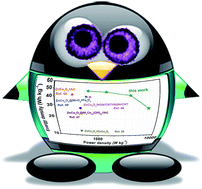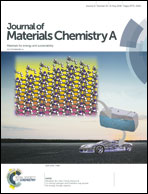In situ construction of yolk–shell zinc cobaltite with uniform carbon doping for high performance asymmetric supercapacitors†
Abstract
Zinc cobaltite (ZnCo2O4) is a promising material for supercapacitors with appreciable theoretical capacitance. However, it suffers from poor electrical conductivity and large volume expansion during charge–discharge processes. In this work, a novel material, ZnCo2O4/C microspheres in a yolk–shell structure, is fabricated by a facile refluxing process in combination with a calcination treatment. Carbon is in situ formed via the pyrolysis of polyvinyl pyrrolidone and uniformly dispersed both in the core and the shell. Benefiting from the unique structure and the synergistic effect of the two components, this material exhibits remarkable electrochemical properties such as high specific capacitance (1821 F g−1 at 5 A g−1), excellent rate performance, and superior cycling stability (no capacitance loss over 9000 cycles). The assembled asymmetric supercapacitor coupled with an active carbon anode can deliver a high energy density of 45.9 W h kg−1 at a power density of 700 W kg−1 with an excellent cycling stability (i.e. a capacitance retention rate over 95% after 9000 cycles).



 Please wait while we load your content...
Please wait while we load your content...